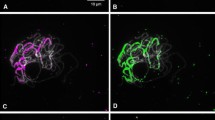Abstract
The putrescine N-methyltransferase (PMT) cDNA clone previously isolated from tobacco encodes a spermidine synthase-like protein with an 11 amino acid element repeated four times in tandem at the amino terminus. Genomic Southern blot analyses indicated that this N-terminal repeat array is found in tobacco PMTs but absent in Hyoscyamus and Atropa PMTs. A truncated tobacco PMT in which this repeat array was entirely removed still retained full enzymatic activity when expressed in Escherichia coli. Three PMT genes (NsPMT1, NsPMT2, NsPMT3) isolated from Nicotiana sylvestris encode two, five, and nine tandem repeats, respectively, in the first exon, but otherwise encode highly conserved proteins. Analysis of PCR fragments amplified from the genomes of N. tabacum and its two probable progenitors shows that one of the nine repeat elements in NsPMT3 was precisely deleted in the corresponding N. tabacum gene. These results indicate that direct tandem repeats of a 33 bp sequence that encodes 11 amino acids of no obvious function were added to the ancestral Nicotiana PMT gene, and that the tandem repetition was genetically very unstable, contracting or expanding during evolution of the Nicotiana species.
Similar content being viewed by others
References
Bradford MM: A rapid and sensitive method for the quantitation of microgram quantities of protein utilising the principle of proteindye binding. Anal Biochem 72: 248–254 (1976).
Dangl JL, Hahlbrock K, Schell J: Regulation and structure of chalcone synthase genes. In: Schell J, Vasil IK (eds) Cell Culture and Somatic Cell Genetics of Plants, vol. 6, pp. 155–173 (1989).
Dank C, Tamaki S, Dunsmuir P, Favreau M, Katayama C, Dooner H, Bedbrook J: mRNA transcripts of several plant genes are polyadenylated at multiple sites in vivo. Nucl Acids Res 14: 2229–2240 (1986).
Facchini PJ, Chappell J: Gene family for an elicitorinduced sesquiterpene cyclase in tobacco. Proc Natl Acad Sci USA 89: 11088–11092 (1992).
Fickett JW: Finding genes by computer: the state of the art. Trends Genet 12: 316–320 (1996).
Gangloff S, Zou H, Rothstein R: Gene conversion plays the major role in controlling the stability of large tandem repeats in yeast. EMBO J 15: 1715–1725 (1996).
Hashimoto T, Yamada Y: Alkaloid biogenesis: molecular aspects. Annu Rev Plant Physiol Plant Mol Biol 45: 257–285 (1994).
Hashimoto T, Yukimune Y, Yamada Y: Putrescine and putrescine Nmethyltransferase in the biosynthesis of tropane alkaloids in the cultured roots of Hyoscyamus albus. I. Biochemical studies. Planta 178: 123–130 (1989).
Hibi N, Higashiguchi S, Hashimoto T, Yamada Y: Gene expression in tobacco lownicotine mutants. Plant Cell 6: 723–735 (1994).
Kanegae T, Kajiya H, Amano Y, Hashimoto T, Yamada Y: Speciesdependent expression of the hyoscyamine 6βhydroxylase gene in the pericycle. Plant Physiol 105: 483–490 (1994).
Kenton A, Parokonny AS, Gleba YY, Bennett MD: Characterization of the Nicotiana tabacum L. genome by molecular cytogenetics. Mol Gen Genet 240: 159–169 (1993).
Kobe B, Deisenhofer J: The leucinerich repeat: a versatile binding motif. Trends Biol Sci 19: 415–421 (1994).
Logemann E, Parniske M, Hahlbrock K: Modes of expression and common structural features of the complete phenylalanine ammonialyase gene family in parsley. Proc Natl Acad Sci USA 92: 5905–5909 (1995).
Muskavitch MA, Hogness DS: An expandable gene that encodes a Drosophila glue protein is not expressed in variants lacking remote upstream sequences. Cell 29: 1041–1051 (1982).
Nakajima K, Hashimoto T, Yamada Y: Two tropinone reductases with different stereospecificities are shortchain dehydrogenases evolved from a common ancestor. Proc Natl Acad Sci USA 90: 9591–9595 (1993).
Nawrotzki R, Blake DJ, Davies KE: The genetic basis of neuromuscular disorders. Trends Genet 12: 294–298 (1996).
Okamuro JK, Goldberg RB: Tobacco singlecopy DNA is highly homologous to sequences present in the genomes of its diploid progenitors. Mol Gen Genet 198: 290–298 (1985).
Sambrook J, Fritsch EF, Maniatis T: Molecular Cloning: A Laboratory Manual. Cold Springer Harbor Laboratory Press, Cold Spring Harbor, NY (1989).
Sato F, Kitajima S, Koyama T, Yamada Y: Ethyleneinduced gene expression of osmotinlike protein, a neutral isoform of tobacco PR5, is medicated by the AGCCGCC cissequence. Plant Cell Physiol 37: 249–255 (1996).
Singer M, Berg P: Genes and Genomes. Blackwell Scientific Publications, Oxford, pp. 659–676 (1991).
Szostak JW, Wu R: Unequal crossing over in the ribosomal DNA of Saccharomyces cerevisiae. Nature 284: 426–430 (1980).
Tran HT, Degtyareva NP, Koloteva NN, Sugino A, Masumoto H, Gordenin DA, Resnick MA: Replication slippage between distant short repeats in Saccharomyces cerevisiae depends on the direction of replication and the RAD50 and RAD52 genes. Mol Cell Biol 15: 5607–5617 (1995).
Author information
Authors and Affiliations
Rights and permissions
About this article
Cite this article
Hashimoto, T., Shoji, T., Mihara, T. et al. Intraspecific variability of the tandem repeats in Nicotiana putrescine N-methyltransferases. Plant Mol Biol 37, 25–37 (1998). https://doi.org/10.1023/A:1005961122814
Issue Date:
DOI: https://doi.org/10.1023/A:1005961122814




